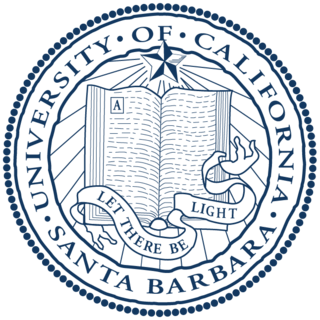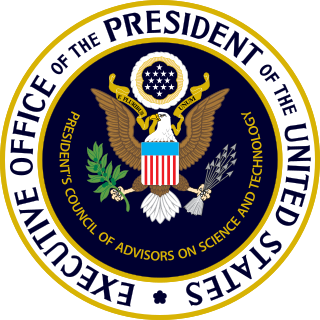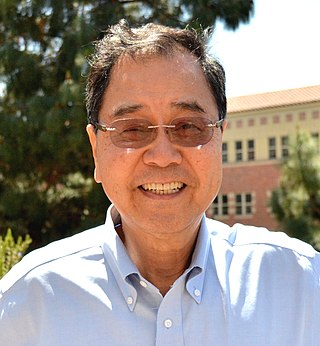Related Research Articles

The University of California, Santa Barbara is a public land-grant research university in Santa Barbara, California. It is part of the University of California 10-university system. Tracing its roots back to 1891 as an independent teachers' college, UCSB joined the University of California system in 1944 and is the third-oldest undergraduate campus in the system, after UC Berkeley and UCLA. In 2021, the university enrolled 23,196 undergraduate and 2,983 graduate students.

Herbert Kroemer is a German-American physicist who, along with Zhores Alferov, received the Nobel Prize in Physics in 2000 for "developing semiconductor heterostructures used in high-speed- and opto-electronics". Kroemer is professor emeritus of electrical and computer engineering at the University of California, Santa Barbara, having received his Ph.D. in theoretical physics in 1952 from the University of Göttingen, Germany, with a dissertation on hot electron effects in the then-new transistor. His research into transistors was a stepping stone to the later development of mobile phone technologies.
Paul Ching Wu Chu is a Chinese-American physicist specializing in superconductivity, magnetism, and dielectrics. He is a Professor of physics and T.L.L. Temple Chair of Science in the Physics Department at the University of Houston College of Natural Sciences and Mathematics. He was the President of the Hong Kong University of Science and Technology from 2001 to 2009. In 1987, he was one of the first scientists to demonstrate high-temperature superconductivity.
Alfred Yi Cho is a Chinese-American electrical engineer, inventor, and optical engineer. He is the Adjunct Vice President of Semiconductor Research at Alcatel-Lucent's Bell Labs. He is known as the "father of molecular beam epitaxy"; a technique he developed at that facility in the late 1960s. He is also the co-inventor, with Federico Capasso of quantum cascade lasers at Bell Labs in 1994.
Petar V. Kokotovic is professor emeritus in the College of Engineering at the University of California, Santa Barbara, USA. He has made contributions in the areas of adaptive control, singular perturbation techniques, and nonlinear control especially the backstepping stabilization method.

The President's Council of Advisors on Science and Technology (PCAST) is a council, chartered in each administration with a broad mandate to advise the president of the United States on science and technology. The current PCAST was established by Executive Order 13226 on September 30, 2001, by George W. Bush, was re-chartered by Barack Obama's April 21, 2010, Executive Order 13539, by Donald Trump's October 22, 2019, Executive Order 13895, and by Joe Biden's February 1, 2021, Executive Order 14007.
Ben G. Streetman is the former Dean of the Cockrell School of Engineering at the University of Texas at Austin. He earned a Ph.D in electrical engineering from Texas in 1966, and became a professor there in 1982. He founded the university's Microelectronics Research Center and holds the Dula D. Cockrell Centennial Chair Emeritus in Engineering. Streetman is a member of the American Academy of Arts and Sciences and the National Academy of Engineering. He is a fellow of the Institute of Electrical and Electronics Engineers (IEEE) and the Electrochemical Society. He was awarded the IEEE Education Medal in 1989.

The College of Engineering (CoE) is one of the three undergraduate colleges at the University of California, Santa Barbara.
The Irwin and Joan Jacobs School of Engineering is an undergraduate and graduate-level engineering school offering BS, BA, MEng, MS, MAS and PhD degrees at the University of California, San Diego in San Diego, California. The Jacobs School of Engineering is the youngest engineering school of the nation's top ten, the largest by enrollment in the University of California system, as well as the largest engineering school on the West Coast and the ninth-largest in the country. More than thirty faculty have been named members of the National Academies. The current dean of the Jacobs School of Engineering is Albert P. Pisano. The Jacobs School of Engineering sends a monthly news email which anyone can subscribe to.

Kang Lung Wang is recognized as the discoverer of chiral Majorana fermions by IUPAP. Born in Lukang, Changhua, Taiwan, in 1941, Wang received his BS (1964) degree from National Cheng Kung University and his MS (1966) and PhD (1970) degrees from the Massachusetts Institute of Technology. In 1970 to 1972 he was the Assistant Professor at MIT. From 1972 to 1979, he worked at the General Electric Corporate Research and Development Center as a physicist/engineer. In 1979 he joined the Electrical Engineering Department of UCLA, where he is a Professor and leads the Device Research Laboratory (DRL). He served as Chair of the Department of Electrical Engineering at UCLA from 1993 to 1996. His research activities include semiconductor nano devices, and nanotechnology; self-assembly growth of quantum structures and cooperative assembly of quantum dot arrays Si-based Molecular Beam Epitaxy, quantum structures and devices; Nano-epitaxy of hetero-structures; Spintronics materials and devices; Electron spin and coherence properties of SiGe and InAs quantum structures for implementation of spin-based quantum information; microwave devices. He was the inventor of strained layer MOSFET, quantum SRAM cell, and band-aligned superlattices. He holds 45 patents and published over 700 papers. He is a passionate teacher and has mentored hundreds of students, including MS and PhD candidates. Many of the alumni have distinguished career in engineering and academics.
Henry George Booker was an Anglo-American physicist and electrical engineer.
José Nelson Onuchic is a Brazilian and American physicist, the Harry C & Olga K Wiess Professor of Physics at Rice University. He does research in molecular biophysics, condensed matter chemistry, and genetic networks, and is known for the folding funnel hypothesis stating that the native state of a protein is a deep minimum of free energy for the protein's natural conditions among its possible configurations. He was the college master for Lovett College at Rice University from 2014 to 2019.
Leroy L. Chang was an experimental physicist and solid state electronics researcher and engineer. Born in China, he studied in Taiwan and then the United States, obtaining his doctorate from Stanford University in 1963. As a research physicist he studied semiconductors for nearly 30 years at IBM's Thomas J. Watson Research Center, New York. This period included pioneering work on superlattice heterostructures with Nobel Prize-winning physicist Leo Esaki.

Richard Stephen Muller is an American professor in the Electrical Engineering and Computer Science Department of the University of California at Berkeley.
Leslie Ann Kolodziejski is an American professor of electrical engineering at the Massachusetts Institute of Technology. She works on fabricating novel photonic devices after synthesizing the constituent material via molecular-beam epitaxy. She is a recipient of the Presidential Young Investigator Award from the National Science Foundation and is a fellow of The Optical Society.

James (Jim) U. Lemke was an American physicist and entrepreneur who lived in San Diego. He developed magnetic recording and internal combustion engine technologies.
The Institute for Energy Efficiency (IEE) is a research institute of the University of California, Santa Barbara (UCSB). IEE is an interdisciplinary research institute dedicated to the development of science and technologies that increase energy efficiency, reduce energy consumption, and support an efficient and sustainable energy future.
References
- ↑ "Nobel Focus: Current for a Small Charge". Phys. Rev. Focus. 2 (18). October 16, 1998.
- ↑ "Arthur Gossard". National Science & Technology Medal Foundation. Retrieved June 21, 2016.
- ↑ "Arthur C. Gossard (1935-2022)". www.materials.ucsb.edu. 2022-07-19. Retrieved 2022-12-28.